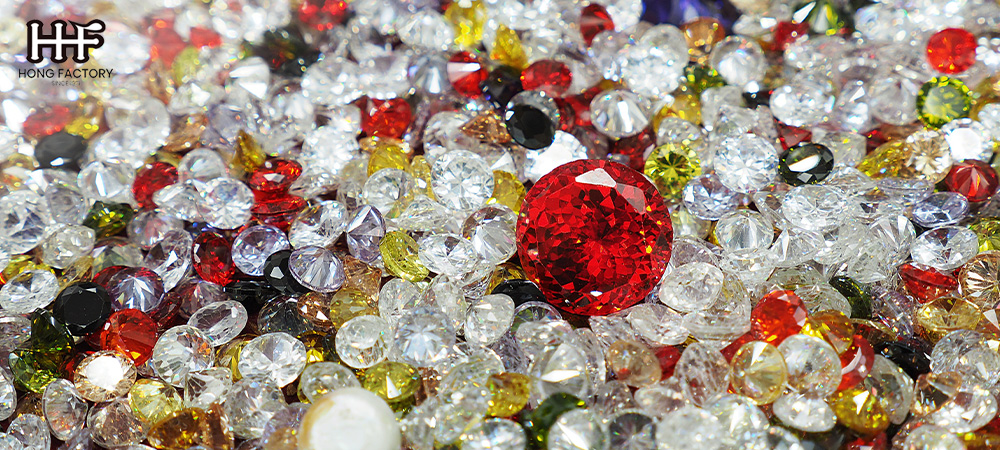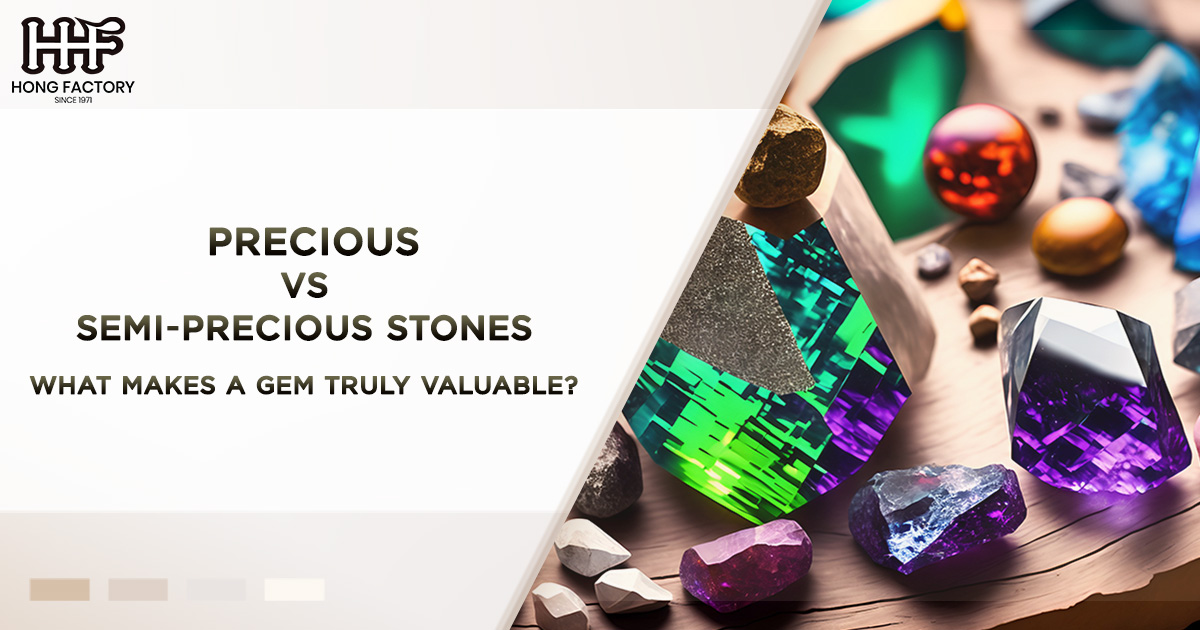Gemstones have fascinated humans for millennia, prized for their beauty, rarity, and the mystique that surrounds them. These shimmering wonders of nature have been used in jewelry, religious artifacts, and even as symbols of power and status. However, not all gemstones are created equal. The distinction between precious and semi-precious stones has long been an essential classification in the world of gems, but what exactly makes a gemstone truly valuable? In this article, we will explore the different categories of gemstones, the factors that determine their value, and dissect the key differences between precious and semi-precious stones.
Precious vs. Semi-Precious Stones – Understanding the Classification
Historically, gemstones have been divided into two broad categories – precious and semi-precious. This distinction, however, is rooted more in tradition than in any scientific or objective criteria. The term “precious” has often been reserved for a select few gems, while “semi-precious” has been applied to the remaining stones. But as we will see, the line between these two groups is not always clear-cut.
Four Precious Stones
Traditionally, precious stones include four gems – diamond, ruby, sapphire, and emerald. These four have been considered the most valuable gemstones due to their rarity, beauty, and historical importance. Let’s take a closer look at each –
1. Ruby – Often referred to as the “king of gemstones,” the ruby’s value is determined by its intense red color. The most prized rubies display a deep, vibrant red, sometimes referred to as “pigeon blood red.” Rubies are part of the corundum family, the same mineral family as sapphires, but their distinct red hue sets them apart. The rarity of fine rubies, especially in larger sizes, contributes to their high value.
2. Sapphire – Known for its signature deep blue color, sapphires can actually come in a variety of colors, including pink, yellow, and green. Blue sapphires, however, are the most coveted. Like rubies, sapphires are also a form of corundum, and their value is largely determined by color, clarity, and size. The finest blue sapphires often come from Kashmir, Sri Lanka, and Myanmar, though other regions also produce high-quality stones.
3. Emerald – With its lush green hue, emerald has long been associated with royalty and the natural world. Emeralds belong to the beryl mineral family and are prized for their rich color and transparency. However, emeralds often have inclusions or internal flaws, which are accepted as part of their natural beauty. The most valuable emeralds are those with intense, vivid green tones and minimal inclusions, typically sourced from Colombia.
4. Diamond – The diamond is arguably the most famous gemstone, renowned for its incredible hardness and brilliance. Unlike the other precious stones, diamonds are judged primarily based on the “four Cs” – cut, color, clarity, and carat weight. The rarity of large, flawless diamonds contributes to their value, and they are often associated with engagement rings and other significant life events.
Semi-Precious Stones
The term semi-precious stones encompasses a wide variety of gemstones that are considered less rare or valuable than the four precious stones. Some examples of semi-precious stones include –
– Amethyst – Known for its rich purple tones, amethyst was once considered a precious stone until vast deposits were discovered, reducing its rarity.
– Aquamarine – A pale blue to green-blue gem, aquamarine belongs to the same family as emerald (beryl) but is typically more affordable.
– Garnet – Garnets come in a range of colors, including red, green, and orange, with red garnets being the most common.
– Topaz – Often found in golden yellow, blue, or pink, topaz is a popular semi-precious stone.
– Tourmaline – Known for its wide range of colors, tourmaline can be found in shades of green, pink, blue, and even multicolored varieties.
While semi-precious stones are generally more affordable than precious stones, some can still command high prices depending on their quality, color, and rarity.

What Makes a Gem Truly Valuable?
The distinction between precious and semi-precious stones is not the only factor that determines a gem’s value. Several other considerations come into play when assessing the worth of a gemstone. These factors apply to both precious and semi-precious stones and can significantly influence their market value.
1. Color
Color is often the most important factor in determining a gemstone’s value. Gemstones with vivid, intense colors are generally more desirable. For example, in the case of rubies, the deep red “pigeon blood” color is the most valuable. Similarly, the brightest blue sapphires and the richest green emeralds are considered the most prized. Even diamonds, which are often thought of as colorless, can have value influenced by any slight tint of color.
2. Clarity
Clarity refers to the presence (or absence) of inclusions or internal flaws within a gemstone. In general, gemstones with fewer inclusions are more valuable, as they allow light to pass through the stone more freely, enhancing its brilliance. However, some stones, such as emeralds, are expected to have inclusions, and these do not detract as much from their value. In fact, inclusions known as “jardin” are considered part of an emerald’s character.
3. Cut
The cut of a gemstone affects how it reflects light, which in turn impacts its brilliance and overall beauty. A well-cut gemstone will maximize light return, making it appear more radiant. Poorly cut gems may appear dull or lifeless, even if they have good color and clarity. The precision and skill involved in cutting a gem can significantly influence its value.
4. Carat Weight
Carat weight refers to the size of the gemstone. Larger gemstones are rarer and, as a result, more valuable. However, carat weight alone does not determine a gem’s value. A large stone with poor color or clarity will be less valuable than a smaller, high-quality gem.
5. Rarity
Rarity is a key factor in a gemstone’s value. Some semi-precious stones, such as Paraíba tourmaline or alexandrite, are extremely rare and can be more valuable than some precious stones. The scarcity of fine-quality specimens in the marketplace can drive up the price of certain gems, regardless of their classification.
6. Origin
The geographic origin of a gemstone can also influence its value. For example, sapphires from Kashmir, rubies from Myanmar, and emeralds from Colombia are often regarded as the most desirable due to these regions’ reputation for producing high-quality gems. The source of a gemstone can add a level of prestige and rarity, further enhancing its value.
Shifting Perceptions of Value
In recent years, the distinction between precious and semi-precious stones has become less rigid. Many semi-precious stones, such as tanzanite and spinel, have gained recognition for their beauty and rarity, challenging the traditional hierarchy. Moreover, factors such as ethical sourcing and environmental sustainability are becoming increasingly important to consumers, adding another dimension to the concept of value in the gem market.
Some gemologists and industry experts now argue that the precious vs. semi-precious classification is outdated and overly simplistic. Instead, they advocate for a more nuanced approach that considers the individual characteristics of each stone, such as color, clarity, cut, and rarity, rather than relying on historical classifications.
Conclusion – Beyond Labels – The True Value of Gemstones
In the end, what makes a gemstone truly valuable is a combination of factors, including its color, clarity, cut, carat weight, rarity, and origin. While the traditional distinction between precious and semi-precious stones provides a helpful framework, it does not capture the full complexity of gemstone valuation. Whether a gemstone is classified as precious or semi-precious, its true worth lies in its unique beauty, the skill with which it has been cut, and the rarity of high-quality specimens.
As the gemstone market evolves, so too do perceptions of value. Today, consumers have the opportunity to appreciate a broader array of gemstones, from the traditional rubies, sapphires, and emeralds to the lesser-known but equally stunning semi-precious stones. Regardless of classification, the allure of gemstones endures, captivating the hearts and imaginations of people around the world.
